Les Mills: Strategic Analysis of Fitness Industry in New Zealand
VerifiedAdded on 2020/03/23
|9
|2228
|551
Report
AI Summary
This report offers a comprehensive strategic analysis of Les Mills, a prominent player in the New Zealand fitness industry. It begins with an examination of Les Mills' strategic directions through a PESTLE analysis, evaluating the political, economic, social, technological, legal, and environmental factors impacting the company. The report then delves into SWOT and Porter's Five Forces analyses to assess the company's strengths, weaknesses, opportunities, threats, and competitive dynamics. Furthermore, it explores Les Mills' human resource planning, emphasizing its focus on employee training, performance management, and succession planning. The report highlights Les Mills' competitive advantages, including its innovation culture, highly trained staff, and ability to merge physical and digital fitness experiences. The conclusion summarizes the key findings and provides recommendations for the company's future growth, including expanding into diet programs and programs for children. The report references various sources to support its analysis.

LES MILLS NEW ZEALAND
Paraphrase This Document
Need a fresh take? Get an instant paraphrase of this document with our AI Paraphraser
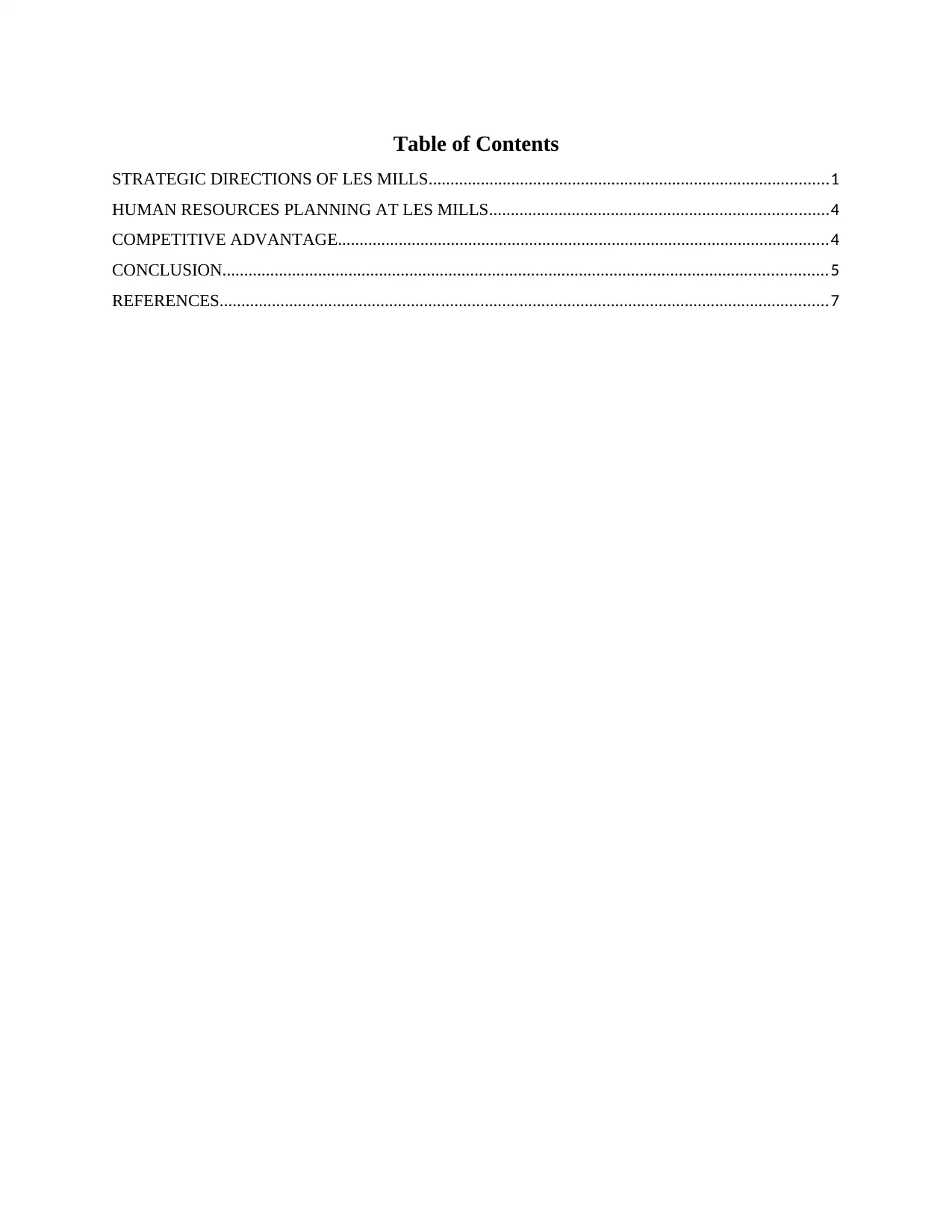
Table of Contents
STRATEGIC DIRECTIONS OF LES MILLS............................................................................................1
HUMAN RESOURCES PLANNING AT LES MILLS..............................................................................4
COMPETITIVE ADVANTAGE.................................................................................................................4
CONCLUSION...........................................................................................................................................5
REFERENCES............................................................................................................................................7
STRATEGIC DIRECTIONS OF LES MILLS............................................................................................1
HUMAN RESOURCES PLANNING AT LES MILLS..............................................................................4
COMPETITIVE ADVANTAGE.................................................................................................................4
CONCLUSION...........................................................................................................................................5
REFERENCES............................................................................................................................................7
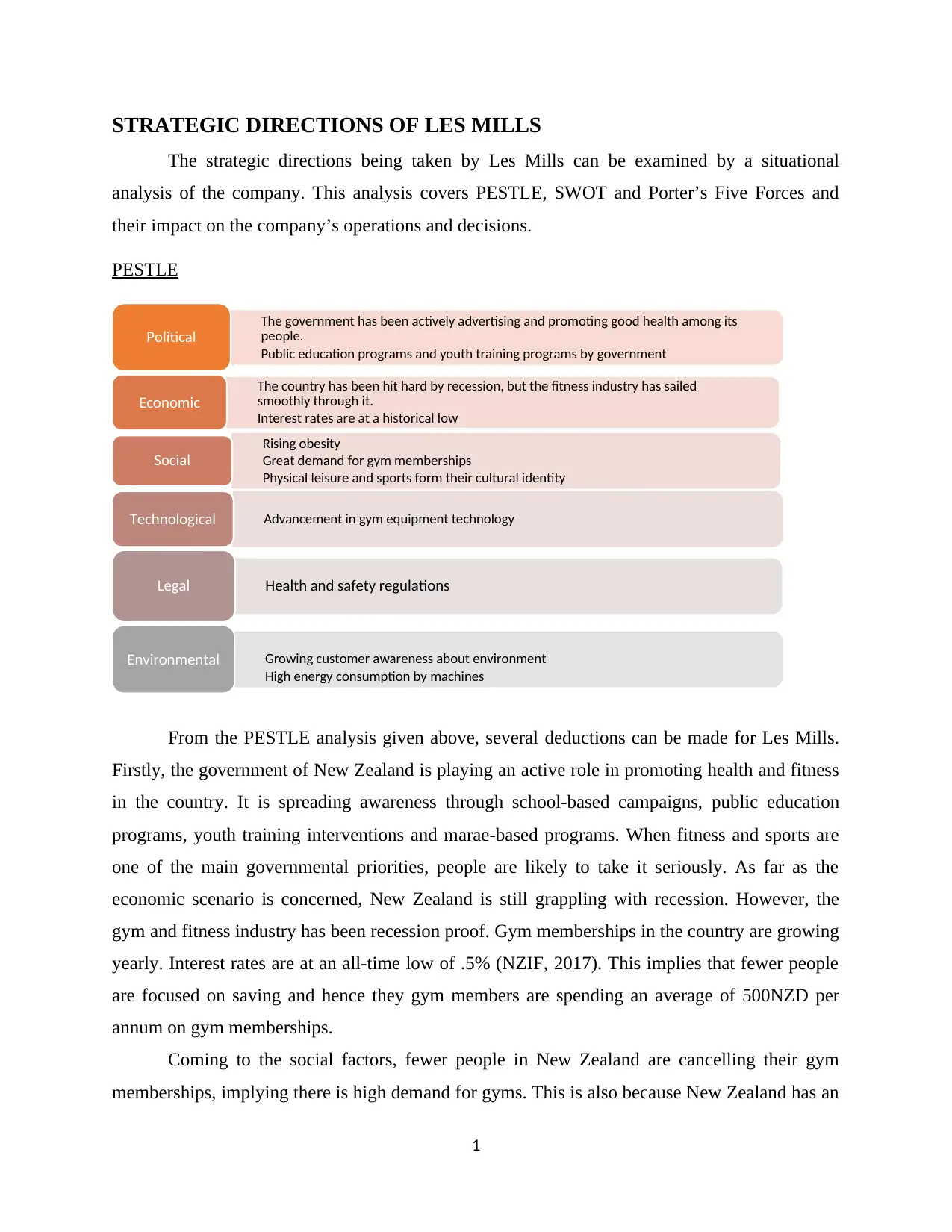
STRATEGIC DIRECTIONS OF LES MILLS
The strategic directions being taken by Les Mills can be examined by a situational
analysis of the company. This analysis covers PESTLE, SWOT and Porter’s Five Forces and
their impact on the company’s operations and decisions.
PESTLE
From the PESTLE analysis given above, several deductions can be made for Les Mills.
Firstly, the government of New Zealand is playing an active role in promoting health and fitness
in the country. It is spreading awareness through school-based campaigns, public education
programs, youth training interventions and marae-based programs. When fitness and sports are
one of the main governmental priorities, people are likely to take it seriously. As far as the
economic scenario is concerned, New Zealand is still grappling with recession. However, the
gym and fitness industry has been recession proof. Gym memberships in the country are growing
yearly. Interest rates are at an all-time low of .5% (NZIF, 2017). This implies that fewer people
are focused on saving and hence they gym members are spending an average of 500NZD per
annum on gym memberships.
Coming to the social factors, fewer people in New Zealand are cancelling their gym
memberships, implying there is high demand for gyms. This is also because New Zealand has an
1
The government has been actively advertising and promoting good health among its
people.
Public education programs and youth training programs by government
Political
The country has been hit hard by recession, but the fitness industry has sailed
smoothly through it.
Interest rates are at a historical low
Economic
Rising obesity
Great demand for gym memberships
Physical leisure and sports form their cultural identity
Social
Advancement in gym equipment technologyTechnological
Health and safety regulationsLegal
Growing customer awareness about environment
High energy consumption by machines
Environmental
The strategic directions being taken by Les Mills can be examined by a situational
analysis of the company. This analysis covers PESTLE, SWOT and Porter’s Five Forces and
their impact on the company’s operations and decisions.
PESTLE
From the PESTLE analysis given above, several deductions can be made for Les Mills.
Firstly, the government of New Zealand is playing an active role in promoting health and fitness
in the country. It is spreading awareness through school-based campaigns, public education
programs, youth training interventions and marae-based programs. When fitness and sports are
one of the main governmental priorities, people are likely to take it seriously. As far as the
economic scenario is concerned, New Zealand is still grappling with recession. However, the
gym and fitness industry has been recession proof. Gym memberships in the country are growing
yearly. Interest rates are at an all-time low of .5% (NZIF, 2017). This implies that fewer people
are focused on saving and hence they gym members are spending an average of 500NZD per
annum on gym memberships.
Coming to the social factors, fewer people in New Zealand are cancelling their gym
memberships, implying there is high demand for gyms. This is also because New Zealand has an
1
The government has been actively advertising and promoting good health among its
people.
Public education programs and youth training programs by government
Political
The country has been hit hard by recession, but the fitness industry has sailed
smoothly through it.
Interest rates are at a historical low
Economic
Rising obesity
Great demand for gym memberships
Physical leisure and sports form their cultural identity
Social
Advancement in gym equipment technologyTechnological
Health and safety regulationsLegal
Growing customer awareness about environment
High energy consumption by machines
Environmental
⊘ This is a preview!⊘
Do you want full access?
Subscribe today to unlock all pages.

Trusted by 1+ million students worldwide
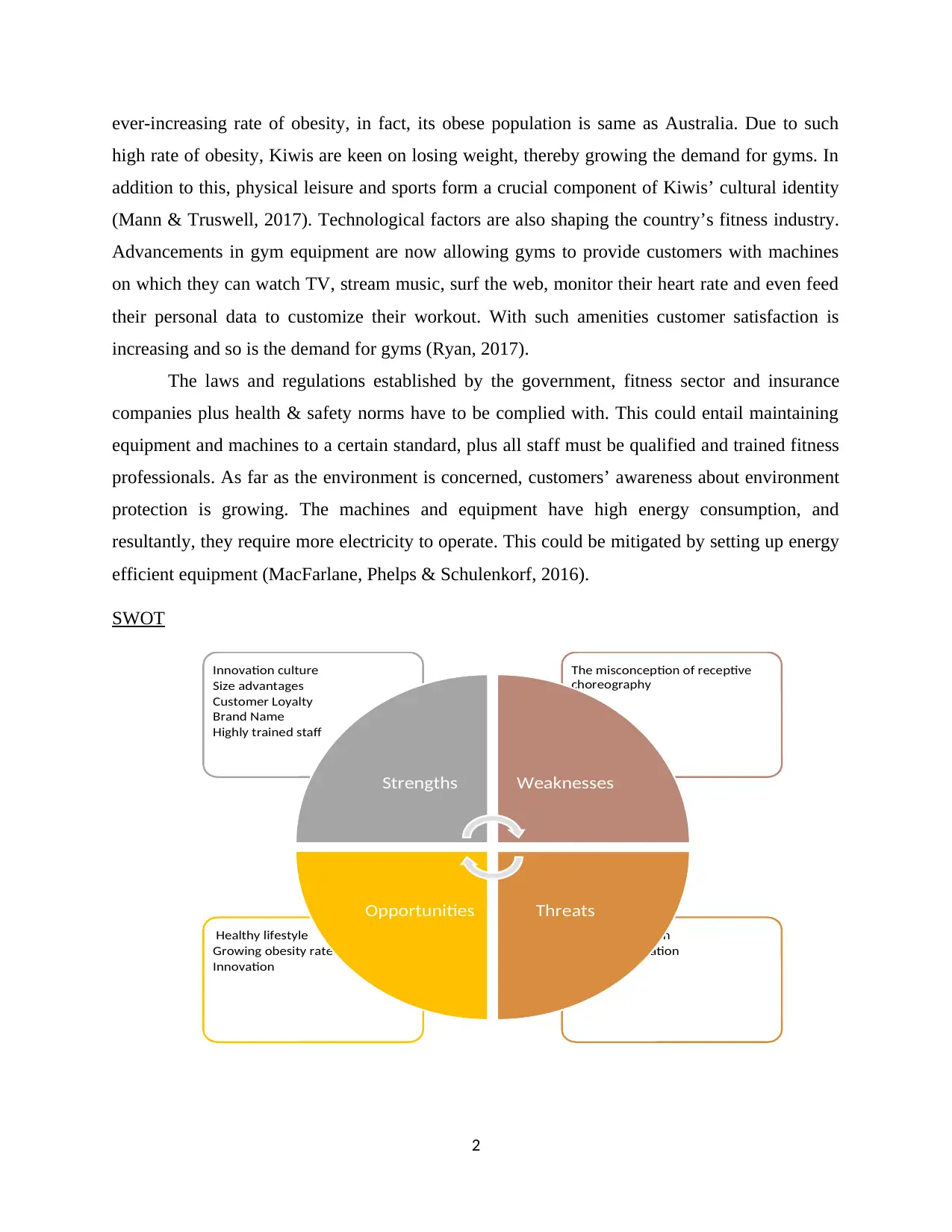
ever-increasing rate of obesity, in fact, its obese population is same as Australia. Due to such
high rate of obesity, Kiwis are keen on losing weight, thereby growing the demand for gyms. In
addition to this, physical leisure and sports form a crucial component of Kiwis’ cultural identity
(Mann & Truswell, 2017). Technological factors are also shaping the country’s fitness industry.
Advancements in gym equipment are now allowing gyms to provide customers with machines
on which they can watch TV, stream music, surf the web, monitor their heart rate and even feed
their personal data to customize their workout. With such amenities customer satisfaction is
increasing and so is the demand for gyms (Ryan, 2017).
The laws and regulations established by the government, fitness sector and insurance
companies plus health & safety norms have to be complied with. This could entail maintaining
equipment and machines to a certain standard, plus all staff must be qualified and trained fitness
professionals. As far as the environment is concerned, customers’ awareness about environment
protection is growing. The machines and equipment have high energy consumption, and
resultantly, they require more electricity to operate. This could be mitigated by setting up energy
efficient equipment (MacFarlane, Phelps & Schulenkorf, 2016).
SWOT
2
High competition
Ageing population
Healthy lifestyle
Growing obesity rate
Innovation
The misconception of receptive
choreography
Innovation culture
Size advantages
Customer Loyalty
Brand Name
Highly trained staff
Strengths Weaknesses
ThreatsOpportunities
high rate of obesity, Kiwis are keen on losing weight, thereby growing the demand for gyms. In
addition to this, physical leisure and sports form a crucial component of Kiwis’ cultural identity
(Mann & Truswell, 2017). Technological factors are also shaping the country’s fitness industry.
Advancements in gym equipment are now allowing gyms to provide customers with machines
on which they can watch TV, stream music, surf the web, monitor their heart rate and even feed
their personal data to customize their workout. With such amenities customer satisfaction is
increasing and so is the demand for gyms (Ryan, 2017).
The laws and regulations established by the government, fitness sector and insurance
companies plus health & safety norms have to be complied with. This could entail maintaining
equipment and machines to a certain standard, plus all staff must be qualified and trained fitness
professionals. As far as the environment is concerned, customers’ awareness about environment
protection is growing. The machines and equipment have high energy consumption, and
resultantly, they require more electricity to operate. This could be mitigated by setting up energy
efficient equipment (MacFarlane, Phelps & Schulenkorf, 2016).
SWOT
2
High competition
Ageing population
Healthy lifestyle
Growing obesity rate
Innovation
The misconception of receptive
choreography
Innovation culture
Size advantages
Customer Loyalty
Brand Name
Highly trained staff
Strengths Weaknesses
ThreatsOpportunities
Paraphrase This Document
Need a fresh take? Get an instant paraphrase of this document with our AI Paraphraser
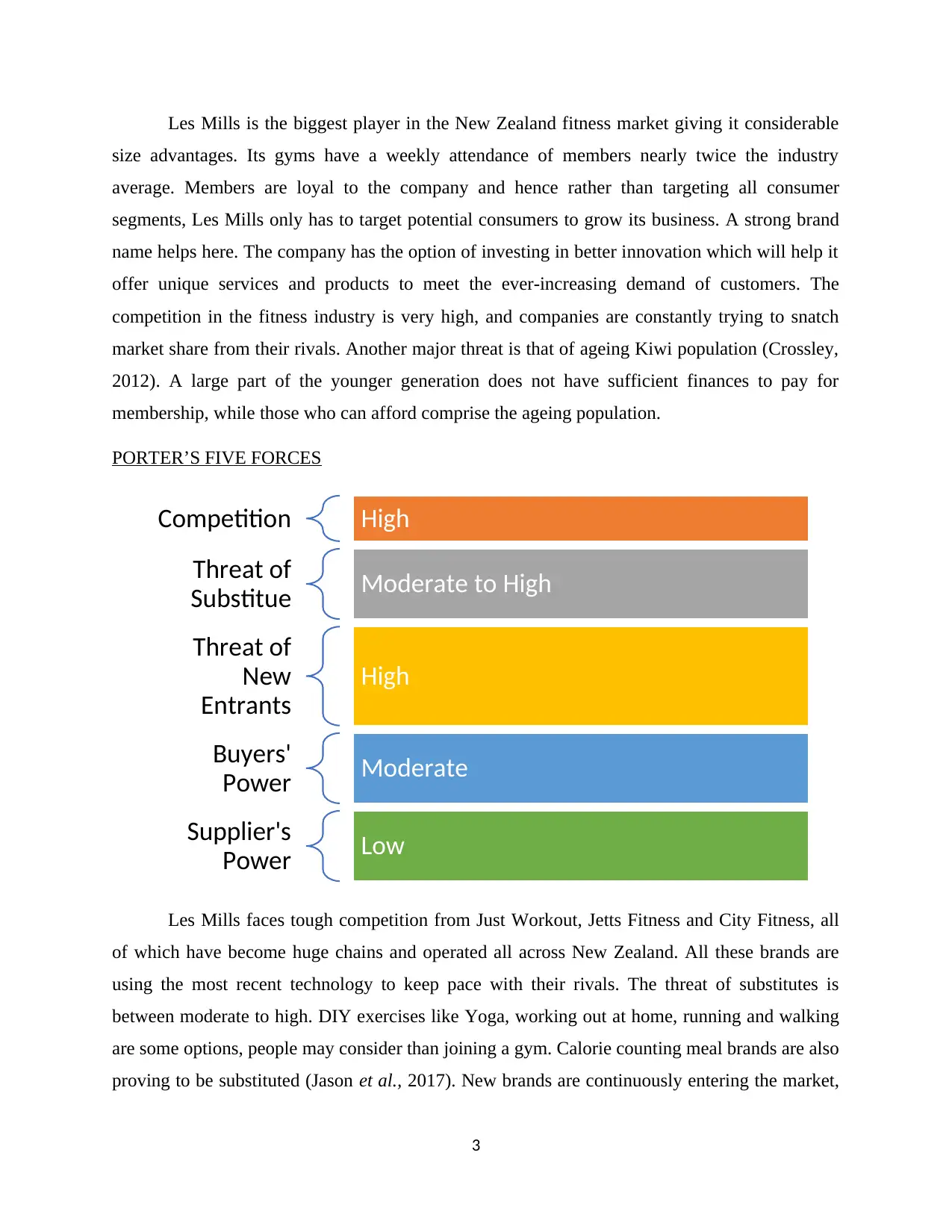
Les Mills is the biggest player in the New Zealand fitness market giving it considerable
size advantages. Its gyms have a weekly attendance of members nearly twice the industry
average. Members are loyal to the company and hence rather than targeting all consumer
segments, Les Mills only has to target potential consumers to grow its business. A strong brand
name helps here. The company has the option of investing in better innovation which will help it
offer unique services and products to meet the ever-increasing demand of customers. The
competition in the fitness industry is very high, and companies are constantly trying to snatch
market share from their rivals. Another major threat is that of ageing Kiwi population (Crossley,
2012). A large part of the younger generation does not have sufficient finances to pay for
membership, while those who can afford comprise the ageing population.
PORTER’S FIVE FORCES
Les Mills faces tough competition from Just Workout, Jetts Fitness and City Fitness, all
of which have become huge chains and operated all across New Zealand. All these brands are
using the most recent technology to keep pace with their rivals. The threat of substitutes is
between moderate to high. DIY exercises like Yoga, working out at home, running and walking
are some options, people may consider than joining a gym. Calorie counting meal brands are also
proving to be substituted (Jason et al., 2017). New brands are continuously entering the market,
3
Competition High
Threat of
Substitue Moderate to High
Threat of
New
Entrants
High
Buyers'
Power Moderate
Supplier's
Power Low
size advantages. Its gyms have a weekly attendance of members nearly twice the industry
average. Members are loyal to the company and hence rather than targeting all consumer
segments, Les Mills only has to target potential consumers to grow its business. A strong brand
name helps here. The company has the option of investing in better innovation which will help it
offer unique services and products to meet the ever-increasing demand of customers. The
competition in the fitness industry is very high, and companies are constantly trying to snatch
market share from their rivals. Another major threat is that of ageing Kiwi population (Crossley,
2012). A large part of the younger generation does not have sufficient finances to pay for
membership, while those who can afford comprise the ageing population.
PORTER’S FIVE FORCES
Les Mills faces tough competition from Just Workout, Jetts Fitness and City Fitness, all
of which have become huge chains and operated all across New Zealand. All these brands are
using the most recent technology to keep pace with their rivals. The threat of substitutes is
between moderate to high. DIY exercises like Yoga, working out at home, running and walking
are some options, people may consider than joining a gym. Calorie counting meal brands are also
proving to be substituted (Jason et al., 2017). New brands are continuously entering the market,
3
Competition High
Threat of
Substitue Moderate to High
Threat of
New
Entrants
High
Buyers'
Power Moderate
Supplier's
Power Low
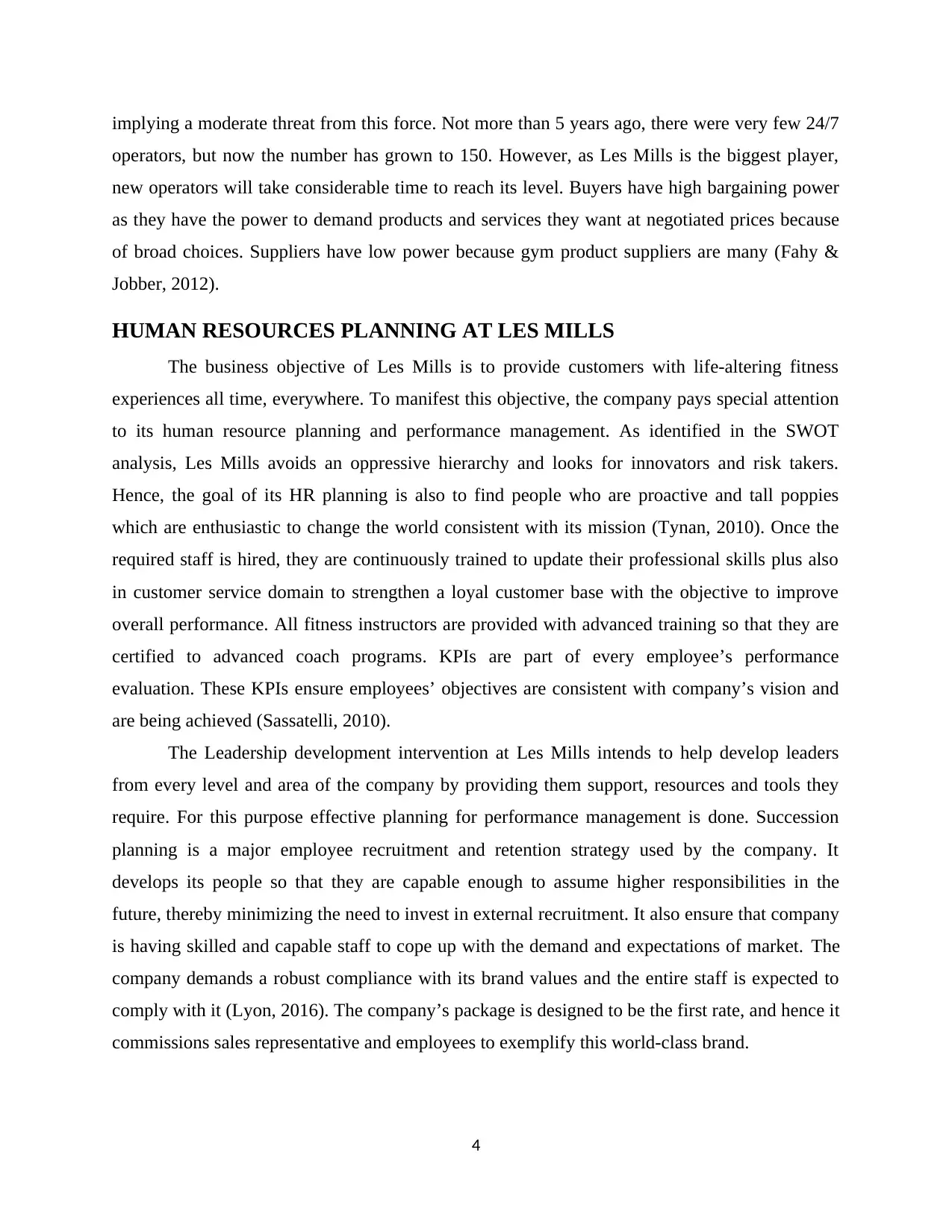
implying a moderate threat from this force. Not more than 5 years ago, there were very few 24/7
operators, but now the number has grown to 150. However, as Les Mills is the biggest player,
new operators will take considerable time to reach its level. Buyers have high bargaining power
as they have the power to demand products and services they want at negotiated prices because
of broad choices. Suppliers have low power because gym product suppliers are many (Fahy &
Jobber, 2012).
HUMAN RESOURCES PLANNING AT LES MILLS
The business objective of Les Mills is to provide customers with life-altering fitness
experiences all time, everywhere. To manifest this objective, the company pays special attention
to its human resource planning and performance management. As identified in the SWOT
analysis, Les Mills avoids an oppressive hierarchy and looks for innovators and risk takers.
Hence, the goal of its HR planning is also to find people who are proactive and tall poppies
which are enthusiastic to change the world consistent with its mission (Tynan, 2010). Once the
required staff is hired, they are continuously trained to update their professional skills plus also
in customer service domain to strengthen a loyal customer base with the objective to improve
overall performance. All fitness instructors are provided with advanced training so that they are
certified to advanced coach programs. KPIs are part of every employee’s performance
evaluation. These KPIs ensure employees’ objectives are consistent with company’s vision and
are being achieved (Sassatelli, 2010).
The Leadership development intervention at Les Mills intends to help develop leaders
from every level and area of the company by providing them support, resources and tools they
require. For this purpose effective planning for performance management is done. Succession
planning is a major employee recruitment and retention strategy used by the company. It
develops its people so that they are capable enough to assume higher responsibilities in the
future, thereby minimizing the need to invest in external recruitment. It also ensure that company
is having skilled and capable staff to cope up with the demand and expectations of market. The
company demands a robust compliance with its brand values and the entire staff is expected to
comply with it (Lyon, 2016). The company’s package is designed to be the first rate, and hence it
commissions sales representative and employees to exemplify this world-class brand.
4
operators, but now the number has grown to 150. However, as Les Mills is the biggest player,
new operators will take considerable time to reach its level. Buyers have high bargaining power
as they have the power to demand products and services they want at negotiated prices because
of broad choices. Suppliers have low power because gym product suppliers are many (Fahy &
Jobber, 2012).
HUMAN RESOURCES PLANNING AT LES MILLS
The business objective of Les Mills is to provide customers with life-altering fitness
experiences all time, everywhere. To manifest this objective, the company pays special attention
to its human resource planning and performance management. As identified in the SWOT
analysis, Les Mills avoids an oppressive hierarchy and looks for innovators and risk takers.
Hence, the goal of its HR planning is also to find people who are proactive and tall poppies
which are enthusiastic to change the world consistent with its mission (Tynan, 2010). Once the
required staff is hired, they are continuously trained to update their professional skills plus also
in customer service domain to strengthen a loyal customer base with the objective to improve
overall performance. All fitness instructors are provided with advanced training so that they are
certified to advanced coach programs. KPIs are part of every employee’s performance
evaluation. These KPIs ensure employees’ objectives are consistent with company’s vision and
are being achieved (Sassatelli, 2010).
The Leadership development intervention at Les Mills intends to help develop leaders
from every level and area of the company by providing them support, resources and tools they
require. For this purpose effective planning for performance management is done. Succession
planning is a major employee recruitment and retention strategy used by the company. It
develops its people so that they are capable enough to assume higher responsibilities in the
future, thereby minimizing the need to invest in external recruitment. It also ensure that company
is having skilled and capable staff to cope up with the demand and expectations of market. The
company demands a robust compliance with its brand values and the entire staff is expected to
comply with it (Lyon, 2016). The company’s package is designed to be the first rate, and hence it
commissions sales representative and employees to exemplify this world-class brand.
4
⊘ This is a preview!⊘
Do you want full access?
Subscribe today to unlock all pages.

Trusted by 1+ million students worldwide
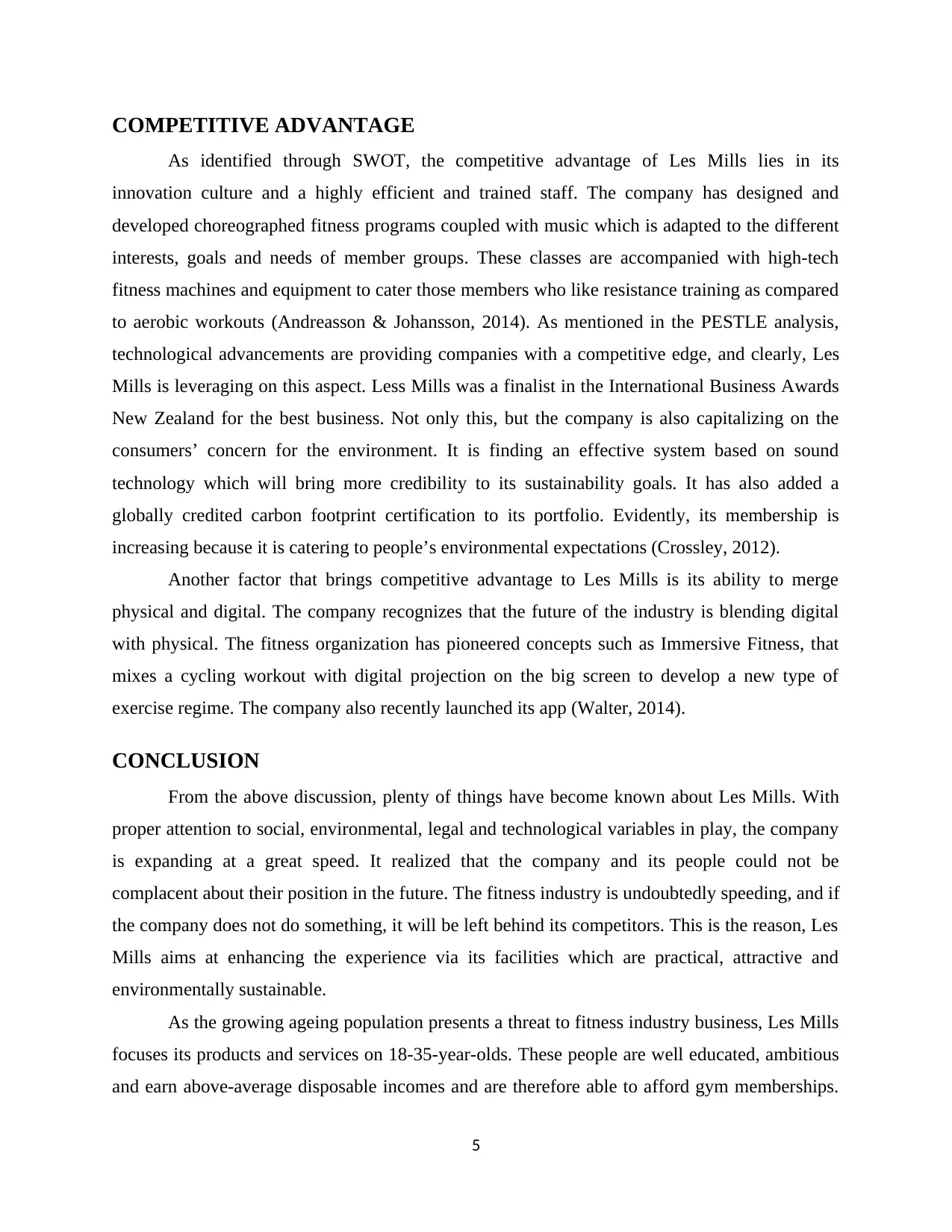
COMPETITIVE ADVANTAGE
As identified through SWOT, the competitive advantage of Les Mills lies in its
innovation culture and a highly efficient and trained staff. The company has designed and
developed choreographed fitness programs coupled with music which is adapted to the different
interests, goals and needs of member groups. These classes are accompanied with high-tech
fitness machines and equipment to cater those members who like resistance training as compared
to aerobic workouts (Andreasson & Johansson, 2014). As mentioned in the PESTLE analysis,
technological advancements are providing companies with a competitive edge, and clearly, Les
Mills is leveraging on this aspect. Less Mills was a finalist in the International Business Awards
New Zealand for the best business. Not only this, but the company is also capitalizing on the
consumers’ concern for the environment. It is finding an effective system based on sound
technology which will bring more credibility to its sustainability goals. It has also added a
globally credited carbon footprint certification to its portfolio. Evidently, its membership is
increasing because it is catering to people’s environmental expectations (Crossley, 2012).
Another factor that brings competitive advantage to Les Mills is its ability to merge
physical and digital. The company recognizes that the future of the industry is blending digital
with physical. The fitness organization has pioneered concepts such as Immersive Fitness, that
mixes a cycling workout with digital projection on the big screen to develop a new type of
exercise regime. The company also recently launched its app (Walter, 2014).
CONCLUSION
From the above discussion, plenty of things have become known about Les Mills. With
proper attention to social, environmental, legal and technological variables in play, the company
is expanding at a great speed. It realized that the company and its people could not be
complacent about their position in the future. The fitness industry is undoubtedly speeding, and if
the company does not do something, it will be left behind its competitors. This is the reason, Les
Mills aims at enhancing the experience via its facilities which are practical, attractive and
environmentally sustainable.
As the growing ageing population presents a threat to fitness industry business, Les Mills
focuses its products and services on 18-35-year-olds. These people are well educated, ambitious
and earn above-average disposable incomes and are therefore able to afford gym memberships.
5
As identified through SWOT, the competitive advantage of Les Mills lies in its
innovation culture and a highly efficient and trained staff. The company has designed and
developed choreographed fitness programs coupled with music which is adapted to the different
interests, goals and needs of member groups. These classes are accompanied with high-tech
fitness machines and equipment to cater those members who like resistance training as compared
to aerobic workouts (Andreasson & Johansson, 2014). As mentioned in the PESTLE analysis,
technological advancements are providing companies with a competitive edge, and clearly, Les
Mills is leveraging on this aspect. Less Mills was a finalist in the International Business Awards
New Zealand for the best business. Not only this, but the company is also capitalizing on the
consumers’ concern for the environment. It is finding an effective system based on sound
technology which will bring more credibility to its sustainability goals. It has also added a
globally credited carbon footprint certification to its portfolio. Evidently, its membership is
increasing because it is catering to people’s environmental expectations (Crossley, 2012).
Another factor that brings competitive advantage to Les Mills is its ability to merge
physical and digital. The company recognizes that the future of the industry is blending digital
with physical. The fitness organization has pioneered concepts such as Immersive Fitness, that
mixes a cycling workout with digital projection on the big screen to develop a new type of
exercise regime. The company also recently launched its app (Walter, 2014).
CONCLUSION
From the above discussion, plenty of things have become known about Les Mills. With
proper attention to social, environmental, legal and technological variables in play, the company
is expanding at a great speed. It realized that the company and its people could not be
complacent about their position in the future. The fitness industry is undoubtedly speeding, and if
the company does not do something, it will be left behind its competitors. This is the reason, Les
Mills aims at enhancing the experience via its facilities which are practical, attractive and
environmentally sustainable.
As the growing ageing population presents a threat to fitness industry business, Les Mills
focuses its products and services on 18-35-year-olds. These people are well educated, ambitious
and earn above-average disposable incomes and are therefore able to afford gym memberships.
5
Paraphrase This Document
Need a fresh take? Get an instant paraphrase of this document with our AI Paraphraser
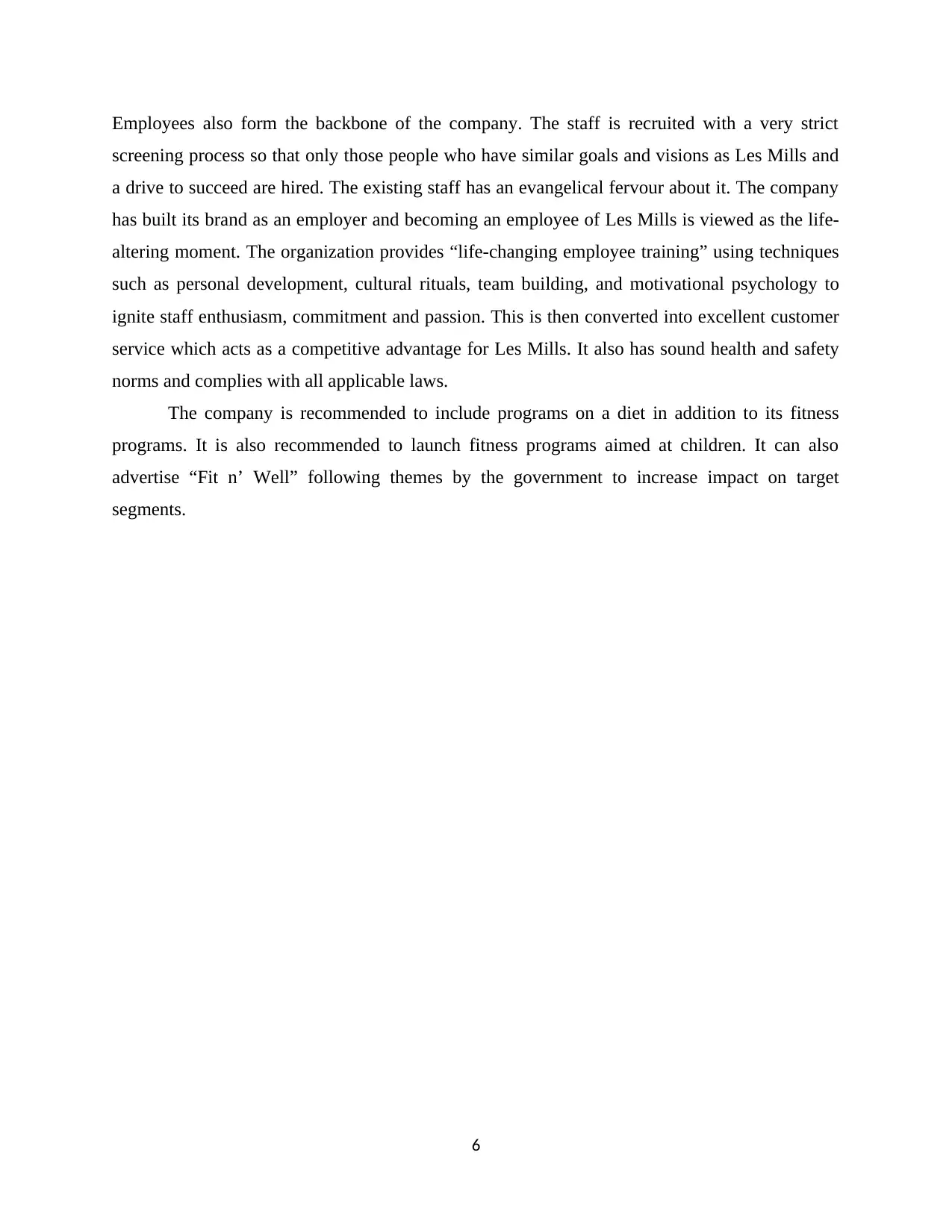
Employees also form the backbone of the company. The staff is recruited with a very strict
screening process so that only those people who have similar goals and visions as Les Mills and
a drive to succeed are hired. The existing staff has an evangelical fervour about it. The company
has built its brand as an employer and becoming an employee of Les Mills is viewed as the life-
altering moment. The organization provides “life-changing employee training” using techniques
such as personal development, cultural rituals, team building, and motivational psychology to
ignite staff enthusiasm, commitment and passion. This is then converted into excellent customer
service which acts as a competitive advantage for Les Mills. It also has sound health and safety
norms and complies with all applicable laws.
The company is recommended to include programs on a diet in addition to its fitness
programs. It is also recommended to launch fitness programs aimed at children. It can also
advertise “Fit n’ Well” following themes by the government to increase impact on target
segments.
6
screening process so that only those people who have similar goals and visions as Les Mills and
a drive to succeed are hired. The existing staff has an evangelical fervour about it. The company
has built its brand as an employer and becoming an employee of Les Mills is viewed as the life-
altering moment. The organization provides “life-changing employee training” using techniques
such as personal development, cultural rituals, team building, and motivational psychology to
ignite staff enthusiasm, commitment and passion. This is then converted into excellent customer
service which acts as a competitive advantage for Les Mills. It also has sound health and safety
norms and complies with all applicable laws.
The company is recommended to include programs on a diet in addition to its fitness
programs. It is also recommended to launch fitness programs aimed at children. It can also
advertise “Fit n’ Well” following themes by the government to increase impact on target
segments.
6
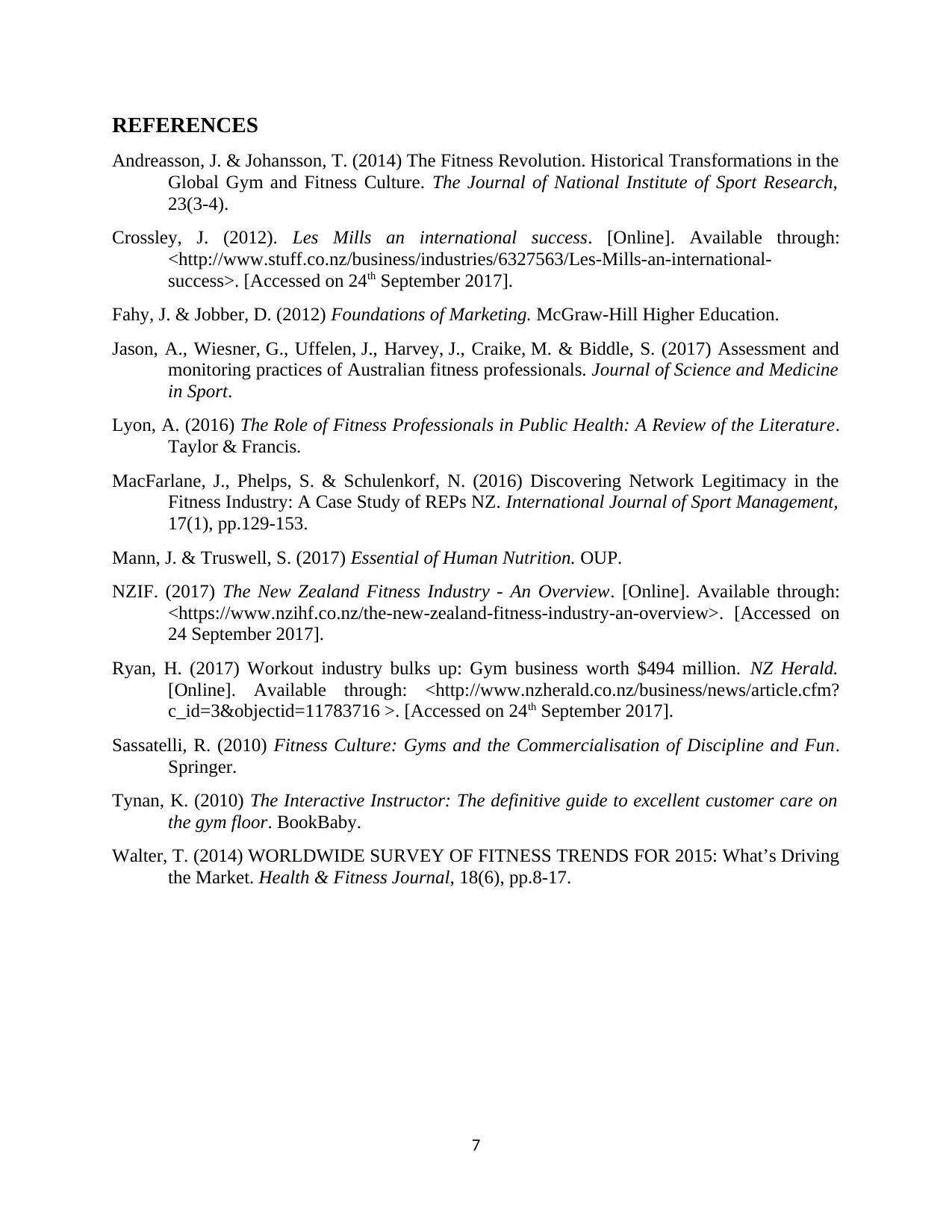
REFERENCES
Andreasson, J. & Johansson, T. (2014) The Fitness Revolution. Historical Transformations in the
Global Gym and Fitness Culture. The Journal of National Institute of Sport Research,
23(3-4).
Crossley, J. (2012). Les Mills an international success. [Online]. Available through:
<http://www.stuff.co.nz/business/industries/6327563/Les-Mills-an-international-
success>. [Accessed on 24th September 2017].
Fahy, J. & Jobber, D. (2012) Foundations of Marketing. McGraw-Hill Higher Education.
Jason, A., Wiesner, G., Uffelen, J., Harvey, J., Craike, M. & Biddle, S. (2017) Assessment and
monitoring practices of Australian fitness professionals. Journal of Science and Medicine
in Sport.
Lyon, A. (2016) The Role of Fitness Professionals in Public Health: A Review of the Literature.
Taylor & Francis.
MacFarlane, J., Phelps, S. & Schulenkorf, N. (2016) Discovering Network Legitimacy in the
Fitness Industry: A Case Study of REPs NZ. International Journal of Sport Management,
17(1), pp.129-153.
Mann, J. & Truswell, S. (2017) Essential of Human Nutrition. OUP.
NZIF. (2017) The New Zealand Fitness Industry - An Overview. [Online]. Available through:
<https://www.nzihf.co.nz/the-new-zealand-fitness-industry-an-overview>. [Accessed on
24 September 2017].
Ryan, H. (2017) Workout industry bulks up: Gym business worth $494 million. NZ Herald.
[Online]. Available through: <http://www.nzherald.co.nz/business/news/article.cfm?
c_id=3&objectid=11783716 >. [Accessed on 24th September 2017].
Sassatelli, R. (2010) Fitness Culture: Gyms and the Commercialisation of Discipline and Fun.
Springer.
Tynan, K. (2010) The Interactive Instructor: The definitive guide to excellent customer care on
the gym floor. BookBaby.
Walter, T. (2014) WORLDWIDE SURVEY OF FITNESS TRENDS FOR 2015: What’s Driving
the Market. Health & Fitness Journal, 18(6), pp.8-17.
7
Andreasson, J. & Johansson, T. (2014) The Fitness Revolution. Historical Transformations in the
Global Gym and Fitness Culture. The Journal of National Institute of Sport Research,
23(3-4).
Crossley, J. (2012). Les Mills an international success. [Online]. Available through:
<http://www.stuff.co.nz/business/industries/6327563/Les-Mills-an-international-
success>. [Accessed on 24th September 2017].
Fahy, J. & Jobber, D. (2012) Foundations of Marketing. McGraw-Hill Higher Education.
Jason, A., Wiesner, G., Uffelen, J., Harvey, J., Craike, M. & Biddle, S. (2017) Assessment and
monitoring practices of Australian fitness professionals. Journal of Science and Medicine
in Sport.
Lyon, A. (2016) The Role of Fitness Professionals in Public Health: A Review of the Literature.
Taylor & Francis.
MacFarlane, J., Phelps, S. & Schulenkorf, N. (2016) Discovering Network Legitimacy in the
Fitness Industry: A Case Study of REPs NZ. International Journal of Sport Management,
17(1), pp.129-153.
Mann, J. & Truswell, S. (2017) Essential of Human Nutrition. OUP.
NZIF. (2017) The New Zealand Fitness Industry - An Overview. [Online]. Available through:
<https://www.nzihf.co.nz/the-new-zealand-fitness-industry-an-overview>. [Accessed on
24 September 2017].
Ryan, H. (2017) Workout industry bulks up: Gym business worth $494 million. NZ Herald.
[Online]. Available through: <http://www.nzherald.co.nz/business/news/article.cfm?
c_id=3&objectid=11783716 >. [Accessed on 24th September 2017].
Sassatelli, R. (2010) Fitness Culture: Gyms and the Commercialisation of Discipline and Fun.
Springer.
Tynan, K. (2010) The Interactive Instructor: The definitive guide to excellent customer care on
the gym floor. BookBaby.
Walter, T. (2014) WORLDWIDE SURVEY OF FITNESS TRENDS FOR 2015: What’s Driving
the Market. Health & Fitness Journal, 18(6), pp.8-17.
7
⊘ This is a preview!⊘
Do you want full access?
Subscribe today to unlock all pages.

Trusted by 1+ million students worldwide
1 out of 9
Your All-in-One AI-Powered Toolkit for Academic Success.
+13062052269
info@desklib.com
Available 24*7 on WhatsApp / Email
![[object Object]](/_next/static/media/star-bottom.7253800d.svg)
Unlock your academic potential
Copyright © 2020–2026 A2Z Services. All Rights Reserved. Developed and managed by ZUCOL.
